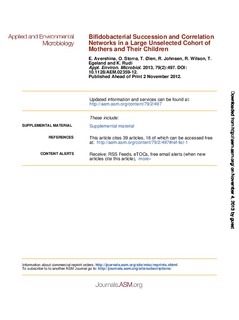| dc.contributor.author | Avershina, Ekaterina | |
| dc.contributor.author | Storrø, Ola | |
| dc.contributor.author | Øien, Torbjørn | |
| dc.contributor.author | Johnsen, Roar | |
| dc.contributor.author | Wilson, Robert | |
| dc.contributor.author | Egeland, Thore | |
| dc.contributor.author | Rudi, Knut | |
| dc.date.accessioned | 2014-02-03T09:56:03Z | |
| dc.date.available | 2014-02-03T09:56:03Z | |
| dc.date.issued | 2013 | |
| dc.identifier.citation | Avershina, Ekaterina, Storrø, Ola, Øien, Torbjørn, Johnsen, Roar, Wilson, Robert, Egeland, Thore, & Rudi, Knut. (2013). Bifidobacterial Succession and Correlation Networks in a Large Unselected Cohort of Mothers and Their Children. Applied and Environmental Microbiology, 79(2), 497-507. doi: http://dx.doi.org10.1128/AEM.02359-12 | no_NO |
| dc.identifier.issn | 0099-2240 | |
| dc.identifier.uri | http://hdl.handle.net/11250/134610 | |
| dc.description | Fagfellevurdert artikkel, publisert i Applied and Environmental Microbiology, 2013. | no_NO |
| dc.description.abstract | Bifidobacteria are a major microbial component of infant gut microbiota, which is believed to promote health benefits for the
host and stimulate maturation of the immune system. Despite their perceived importance, very little is known about the natural development of and possible correlations between bifidobacteria in human populations. To address this knowledge gap, we analyzed stool samples from a randomly selected healthy cohort of 87 infants and their mothers with>90% of vaginal delivery and nearly 100% breast-feeding at 4 months. Fecal material was sampled during pregnancy, at 3 and 10 days, at 4 months, and at 1 and 2 years after birth. Stool samples were predicted to be rich in the species Bifidobacterium adolescentis, B. bifidum, B. den-
tium, B. breve, and B. longum. Due to high variation, we did not identify a clear age-related structure at the individual level.
Within the population as a whole, however, there were clear age-related successions. Negative correlations between the B.
longum group and B. adolescentis were detected in adults and in 1- and 2-year-old children, whereas negative correlations between B. longum and B. breve were characteristic for newborns and 4-month-old infants. The highly structured age-related development of and correlation networks between bifidobacterial species during the first 2 years of life mirrors their different or
competing nutritional requirements, which in turn may be associated with specific biological functions in the development of
healthy gut. | no_NO |
| dc.language.iso | eng | no_NO |
| dc.publisher | American Society for Microbiology | no_NO |
| dc.subject | bifidobacteria | no_NO |
| dc.subject | cohort | no_NO |
| dc.subject | development | no_NO |
| dc.subject | gut microbiota | no_NO |
| dc.subject | mother and child | no_NO |
| dc.title | Bifidobacterial Succession and Correlation Networks in a Large Unselected Cohort of Mothers and Their Children | no_NO |
| dc.type | Journal article | no_NO |
| dc.type | Peer reviewed | no_NO |
| dc.subject.nsi | VDP::Mathematics and natural science: 400::Basic biosciences: 470::General microbiology: 472 | no_NO |
| dc.source.pagenumber | 497-507 | no_NO |
| dc.source.volume | 79 | no_NO |
| dc.source.journal | Applied and Environmental Microbiology | no_NO |
| dc.source.issue | 2 | no_NO |
| dc.identifier.doi | 10.1128/AEM.02359-12 | |
